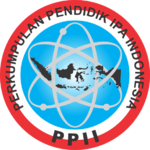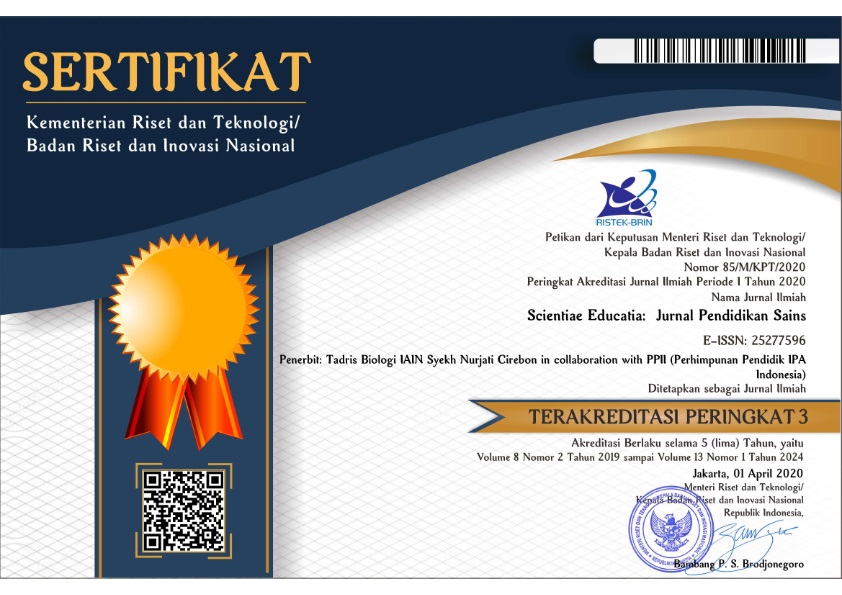Response of Pineapple Callus (Ananas comosus Merr.) through In-Vitro Colchicines Treatment
(1) Institut Ilmu Kesehatan Bhakti Wiyata Kediri
(2) Institut Ilmu Kesehatan Bhakti Wiyata Kediri
(*) Corresponding Author
Abstract
Pineapple Plant (Ananas comosus (L.) Merr) is a fruit plant that has a high economic value. Increased variety of pineapple preparations lead to increased demand for pineapple fruit. Polyploidation is one way to increase the varieties using colchicine. This study aims to know the pineapple explants of callus response after being treated by colchicine using in vitro method. This research used Group Randomized Design (GRD) which variations concentration of Colchicine 0%, 0.01%, 0.05%, and 0.1%. Parameters were observed to response and thickness of callus of pineapple explants. Data were analyzed using F test and DMRT test in which significance level of 5% with SPSS 17 program. The results showed that pineapple plant explant able to respond colchicine concentration marked with thicker callus. The best colchicine treatment to induce pineapple explants callus was concentration 0.1% of colchicine.
Keywords
Full Text:
PDFReferences
Adelanwa, M. A., Habeeb, M. L., Adelanwa, E. B. (2011). Morphological studies of the effect of colchicine and paradichlorobenzene on tomato (Lycopersicon esculentum). Journal of Environmental Issues and Agriculture in Developing Countries 3(2), 122–127. Available online: http://journaldatabase.info/articles/morphological_studies_effect.html.
Al-Khagh, J. M., Jain, S. M., Johnson, D. V. (2015). Advances in Plant Breeding Strategis, Breeding, Biotechnology and Molecular Tools. Vol.1. USA, Springer. DOI: 10.1007/978-3-319-22521-0.
As’adah, M., Rahayu, T., Hayati, A. (2016). Metode pemberian kolkisin terhadap respon morfologis tanaman zaitun (Olea europeae l.). Biosaintropis (Bioscience-Tropic) 2(1), 46–52. Available online: http://biosaintropis.unisma.ac.id/index.php/biosaintropis/ article/view/68.
Ascough, G.D., J. van Staden, J.E. Erwin. (2008). Effectiveness of colchicine andoryzalin at inducing polyploidy in Watsonia lepida n.e. Brown. HortScience 43(7), 2248-2251. Available online: http://hortsci.ashspublications.org/content/43/7/2248.full.
Aurelia, S-J., Hanna, P., Jolanta, W., Tomasz, P. (2017). Improved production of doubled haploids via combination of colchicine treatments on anthers and regenerated plants. J. Appl Genetics 58(3), 287-295. DOI: 10.1007/513353-016.0387-9.
Avery, J. R., George, S., Johnson, E. B. (1947). Hormones and Horticulture. New York and London, Mc. Graw-Hill Book Co Inc.
Azmi, T. K. K., Sukma, D., Aziz, S. A., Syukur, M. (2015). Polyplody induction of moth orchid (Phalenopsis amabilis (l.) Bhime) by colchicine treatment on pollinated flower. The Journal of Agricultural Sciences 11(2), 62-73. DOI: 10.4038/jas.v//i2.8118.
Burns, G. W. (1972). The Science of Genetics, an Introduction to Heredity (Second). New York, The Macamillan Company.
Dhooghe, E., K. Van Laere, T. Eeckhaut, L. Leus, J., Van Huylenbroeck. (2011). Mitotic chromosome doubling of plant tissues in vitro. Plant cell tiss. Organ Cult. 104, 359-373. DOI: 10.1007/s11240-010-9786-5.
Dutt, M., Vasconcellos, M., Song, k. J., Gmitter, F. G., Grosser, J. W. (2009). In vitro production of autotetraploid ponkan mandarin (Citrus reticulata blanco) using cell suspension cultures. Euphtica, 173, 235-242. DOI: 10.1007/510681-009-0058-y.
Eigsti, O. J., Dustin, P. (1957). Colchicine in Agriculture, Medicine, Biology and Chemistery. United State Of America, The Lowa State Collage Press.
El-Nashar, Y. I., Asrar, A. A. (2016). Phenotypic and biochemical profile changes in calendula (Calendula officinalis L.) plants treated with two chemical mutagenesis. Genetic and Molecular Research, 15 (2),gmr.15028071. DOI: 10.4238/gmr.15028071.
Friska, M., Daryono, B. S. (2017). Derajat ploidisasi jahe merah (Zingiber officinale roxb. Var. Rubrum rosc.) hasil induksi dengan kolkisin. Biogenesis 5(1), 49-54. DOI: 10.24252/bio.v4i.3433.
Friska, M., Daryono, B. S. (2017). Karakter fenotip jahe merah (Zingiber officinale var rubrum) hasil poliploidisasi dengan kolkisin. Journal of Biology 10(2), 91-97. DOI: 10.15408/kauniyah.v10.2.4113.
Haryanti, S., Hastuti, R. B., Setiari, N., Banowo, A. (2009). Pengaruh kolkisin terhadap pertumbuhan, ukuran sel metafase dan kandungan protein biji tanaman kacang hijau. Jurnal Penelitian Sains & Teknologi 10(2), 112–120. Available online: https,//publikasiilmiah.ums.ac.id/handle/11617/438.
Hsiao-Hang, C., Shu-Kai, S., Bin, H., Jen-Tsung, C. (2017). Enhanced agronomic traits and medicinal constituenst of autotetraploids in Anoectochilus formosanus hayata, a top-grade medicinal orchid. Moleculer 22(11), 1-13. DOI: 103390/molecules22111907.
keuchi, M., Sugimoto, K., Iwase, A. (2013). Plant callus, mechanisms of induction and repression. The Plant Cell 25(9), 3159-3173. Available online: www.plantcell.org/cgi/doi/10.1105/tpc113.116053.
Kai, Z., Paige, E. N., Xinquan, Z., Genlou, S. (2017). Transcriptome analysis reveals plant respone to colchicine treatment during on chromosome doubling. Scientific Reports 7(1), 1-11. DOI:10.1038/541598-017-08391-2.
Kerdsuwan, N., S. Te-chato. (2012). Effects of colchicine on survival rate, morphological, physiological and cytological characters of chang daeng orchid (Rhyncostylis gigantea var. rubrum sagarik) in vitro. Journal of Agricultural Technology 8(4), 1451-1460. Available online: http://www.ijataatsea.com/pdf/v8_n4_12_July/25_IJAT_ 2012_8_4__ Nattaporn%20%20Kerdsuwan-plant%20science-accepted.pdf.
Khan, S., Nasib, A., Saeed, B. A. (2004). Employment of in vitro technology for large scale multiplication of pineapples (Ananas comosos). Pakistan Journal of Botany 36(3), 611–615. Available online: http://www.pakbs.org/pjbot/PDFs/36(3)/PJB36(3)611.pdf.
Kharde, A. V., Chavan, N. S., Chandre, M. A., Autade, R. H.,
Khetmalas, M. B. (2017). In vitro enhancement of bacoside in brahmi (Bacopa monnieri) using colchicine. J plant biochem physiol 5(1), 1-6. DOI:10.4172/2329-9029.1000172
Nilanthi, D., Chen, X-L., Zhao, F-C., Yang, Y-S., Wu, H. (2009). Induction of tetraploids from petiole explants through colchicine treatments in Echinaceae purpurea L. Journal of Biomedicine and Biotechnology 2009, 1-7. DOI: 10.1155/2009/343485.
Pandey, D. K., Malik, T., Abhijit, D., Singh, J., Banik. (2014). Improved growth and colchicine concentration in Gloriosa superba on mycorrhizal fertilizer. Afr J Tradit Complement Altern Med 11(2), 439-446. http://dx.doi.org/10.4314/ajtcam.vl1i2.30.
Palva, Z., Barbora, S., Holik, A., Eloy, F. C. (2013). In vitro induced mitotic polyploidy Drosera capensis L. Agriculture Tropica Et Subtropica 46(14), 107-110. DOI: 10.2478/ats-2013-0020.
Pharmawati, M., Waitiani, N. L. A. J. (2015). Induksi mutasi kromosom dengan kolkisin pada bawang putih (Allium sativum l.) kultivar “kesuna bali.†Jurnal Bioslogos 5(1), 152–158. Available online: https,//ejournal.unsrat.ac.id/index.php/bioslogos/article/view/ 9317.
Santoso, R. D., Sobir. (2013). Pertumbuhan planlet nenas (Ananas comosus l . merr .) varietas smooth cayenne hasil kultur in vitro pada beberapa konsentrasi BAP. Bul. Agrohorti 1(1), 54–61. Available online: http://agrohort.ipb.ac.id/journal/index.php/agh/ article/view/116.
Shanko, D. (2017). Effects of colchicine and its application in cowpea improvements, review paper. International Journal of Current Innovation Research 3(9), 800-804. Available online: http://journalijcir.com/sites/default/files/issue-files/00579-A-2017_0.pdf.
Silva, P.A.K.X., S. Callegari-Jacques, M.H. Bodanese Zanettini. (2000). Induction and identification of polyploids in Cattleya intermedia Lindl. (Orchidaceae) by In Vitro Techniques. Ciência Rural 30, 105-111. DOI: 10.1590/S0103-84782000000100017.
Simmons, A. R., Bergmann, D. C. (2016). Transcriptional control of cell fate in the stomatal lineage. Current Opinion in Plant Biology; 28, 1-8. DOI: 10.1016/j.pbi.2015.09.008.
Sousa, D. N., Carlier, J., Santo, T., Leitão, J. (2013). An integrated genetic map of pineapple (Ananas comosus (L.) Merr.). Scientia Horticulturae 157, 113–118. DOI: 10.1016/j.scienta.2013.04.018.
Tank, J.G,Thaker, V. S. (2014). Systemic control of cell division and endoreplication by naa and bap by modulating cdks in root tip cell of Allium cepa. BioMed Research International, 1-13. DOI: 10.1155/2014/453707.
Takahira, J., A. Cousin, M.N. Nelson, W.A. Cowling. (2011). Improvement in efficiency of microspore culture to produce doubled haploid canola (Brassica napus l.) By flow cytometry. Plant Cell Tiss. Organ Cult. 104, 51-59. DOI: 10.1007/s11240-010-9803-8.
Wang, X., Cheng, Z-M (MAX), Zhi, S. and Xu, F. (2016). Breeding triploid plants, A Review. Czech, J. Genet. Plant Breed. 52(2), 41-54. DOI: 10.17221/151/2015.CJGPB.
Wardhani, M., and Wiendi, N. M. A. (2012). Induksi Mutasi Genetik Melalui Penggandaan Kromosom Kedelai (Glycine max L. Merr) Varietas Wilis dan Tanggamus dengan Kolkisin Secara In Vitro. Prosiding Simposium Dan Seminar Bersama PERAGI-PERHORTI-PERIPI-HIGI, 274–280. Available online: repository.ipb.ac.id/handle/123456789/60091.
Winaryo, K. A. P., Sugiharto, A. N., & Ainurrasjid. (2016). Penampilan fenotipik 2 galur jagung (zea mays l.) akibat pemberian kolkhisin. Jurnal Produksi Tanaman 4(2), 161–168. Available online: http://protan.studentjournal.ub.ac.id/index.php/protan/ article/view/274/266.
Wurschum, T., Tucker, M. K., reif, J. C. and Maurer, H. P. (2012). Improved efficiency of doubled haploid generation in hexaploid triticale by in vitro chromosome doubling. BMC Plant Biology 12,109. Available online: http://www.biomedcentral.com/1471-2229/121109.
DOI: 10.24235/sc.educatia.v7i1.1919
Article Metrics
Abstract view : 1086 timesPDF - 490 times
Refbacks
- There are currently no refbacks.
Scientiae Educatia: Jurnal Pendidikan Sains indexed by:

This work is licensed under a Creative Commons Attribution 4.0 International License.



1.png)












